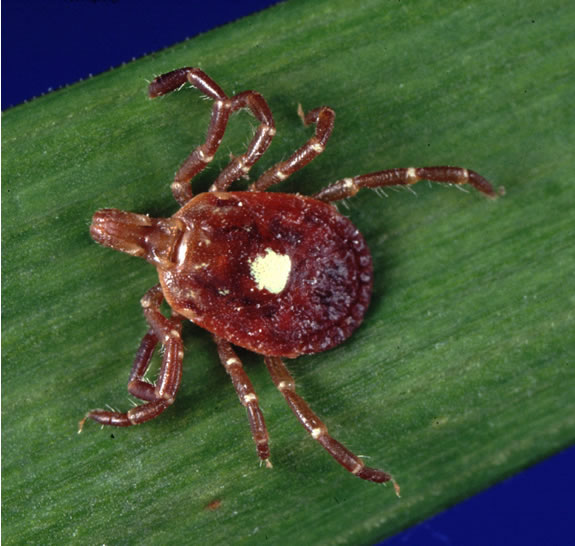Many people are familiar with the ticks that spread Lyme disease, but there are many types of ticks that spread disease in the U.S. One species, the lone star tick, is not associated with Lyme disease but can carry several other dangerous and even deadly pathogens. What’s more, this tick species is spreading into new regions, making it all the more important to stay informed.
In this article, learn how to identify lone star ticks, where lone star ticks are found, what diseases lone star ticks carry, and why it’s crucial to protect yourself from being bitten.

Image source: James Gathany Content Providers(s): CDC/ Michael L. Levin, Ph. D.
What are lone star ticks?
The lone star tick, known scientifically as amblyomma americanum, is a hard-bodied tick endemic to several states in the Southwest, Southeast, Central South, and Midwest. However, the lone star tick does not get its name from the Texas flag, but rather the single white dots found on the backs of adult female lone star ticks.
This dot, along with the slightly larger size of lone star ticks compared to other hard-bodied ticks (such as deer ticks), can help identify lone star ticks and thus the diseases you may be at risk for if you are bitten.
Where are lone star ticks found?
As mentioned, the most common regions where lone star ticks are found are the Southwest, Southeast, Central South, and Midwest. The Centers for Disease Control and Prevention (CDC) report that lone star ticks are more common in the South than any other region; additionally, they are common in the Southwestern state of Texas as well as southern parts of Iowa, Illinois, Ohio, and Pennsylvania.
However, lone star ticks have also been found in increasing numbers as far north as New York, New Hampshire, and Maine, reflecting an expansion of their territory that the public should be aware of to stay safe from tick-borne illnesses.
What diseases do lone star ticks carry?
One of the most important reasons to be aware of lone star tick activity is that lone star ticks carry several disease-causing pathogens, including for diseases that can be deadly. Keep reading to learn about the illnesses lone star ticks can transmit.
Tick-Borne Relapsing Fever
Tick-Borne Relapsing Fever, or TBRF, is caused by the spiral-shaped bacteria of the genus Borrelia and sub-species Relapsing Fever Borrelia (RFB). These Borrelia are closely related to Borrelia burgdorferi, the bacteria that causes Lyme disease. Though lone star ticks do not carry the types of Borrelia that cause Lyme, they have been found to carry the types of Borrelia that cause TBRF.
Symptoms of TBRF can look a lot like Lyme symptoms and do not always include fevers, despite the name.
Ehrlichiosis
Ehrlichiosis is a tick-borne bacterial infection caused by bacteria from the family Anaplasmataceae, genera Ehrlichia. Human Ehrlichiosis disease (HME) can be caused by at least three different ehrlichial species in the United States: Ehrlichia chaffeensis (mononuclear), Ehrlichia ewingii (granulocytes), and Ehrlichia muris-like (mononuclear).
Symptoms usually begin between 5 to 14 days after being bitten by an infected tick and can closely resemble those of other tick-borne diseases, such as Lyme. This includes mild fever, headache, chills, malaise, muscle aches, nausea, vomiting, diarrhea, fatigue, loss of appetite, joint pain, confusion, rash, and cough. While symptoms can be so mild as to go unnoticed, untreated Ehrlichiosis with persistent symptoms can become so severe as to require hospitalization.
Ehrlichiosis must be properly diagnosed and treated with antibiotics in a timely manner in order to fully resolve.
Tularemia
Tularemia is an infectious disease that infects both animals and humans. Sometimes called rabbit fever, tularemia is spread by ticks and insects, handling an infected animal (dead or alive), contaminated water, food, or soil, and even bacteria that has been released into the air. Tick-borne tularemia is spread by the dog tick, wood tick, and lone star tick.
Symptoms of tularemia can vary by the mode of infection, but the most common include high fever, ulcers at the infection site, swelling of lymph glands, irritation and inflammation of the infection site, and pneumonia.
Untreated tularemia can be fatal. Even when not deadly, it can result in complications such as the development of meningitis, pericarditis, and osteomyelitis.
Southern tick-associated rash illness (STARI)
Some people bitten by lone star ticks develop circular rashes that can lead them to believe they’ve been infected with Lyme disease, which can cause a similar-looking “bull’s eye” shaped rash. However, the rash caused by lone star tick bites is not related to Lyme but to a disease known as southern tick-associated rash illness, or STARI.
In addition to a circular rash, STARI can also cause fatigue, headaches, fevers, and muscle pains – all symptoms that can also be associated with Lyme. Because the conditions can look so similar, it is crucial that doctors consider all possible tick-borne diseases when testing a patient with these symptoms, especially if a Lyme test comes back negative.
Heartland virus
Though it is not a bacterial infection but a virus, Heartland virus can look a lot like tick-borne bacterial infections such as Ehrlichiosis and Anaplasmosis. Symptoms include fever, fatigue, decreased appetite, headache, nausea, diarrhea, and muscle or joint pain, and can be so severe that they require hospitalization. Heartland virus can also cause low white blood cell counts in some patients.
Because Heartland virus is not caused by bacteria, it cannot be treated with antibiotics. Medical interventions can only treat symptoms. For this reason, it’s crucial to practice good tick prevention in areas where lone star ticks are common. Recent cases of Heartland virus have been found in Arkansas, Georgia, Illinois, Indiana, Iowa, Kansas, Kentucky, Missouri, North Carolina, Oklahoma, and Tennessee.
Alpha-gal syndrome
Finally, lone star ticks can transmit a sugar molecule called alpha-gal that causes a condition known as alpha-gal syndrome. One of the most characteristic signs of this syndrome is a rare but serious allergy to red meat, triggered by the body’s immune reaction to the foreign alpha-gal molecule.
The allergy can take months to develop but can be quite severe, possibly leading to anaphylactic shock. People with alpha-gal syndrome experience hives, shortness of breath, diarrhea, swelling of the face and hands, and/or low blood pressure shortly after eating red meat. Doctors recommend that people with alpha-gal syndrome carry an epinephrine pen in case of emergencies.
Lone star ticks vs. other tick species
Lone star ticks can be especially dangerous because they are known to be more aggressive than other tick species. Many ticks, such as deer ticks (the ticks that spread Lyme), find animals to feed on by “questing,” or waiting on a leaf or blade of grass until an animal or human walks by. When this happens, the tick climbs on and crawls on the host until it finds a place to bite.
Lone star ticks, by contrast, actually hunt mammals to feed on. They seek out animals and humans by crawling toward them, often in large groups, so that you can end up with many lone star ticks crawling on you at once.
Adult lone star ticks are also larger than adult deer ticks. While this can result in more painful bites, it can also make it easier to see these ticks. It’s always important to perform careful tick checks after spending time outdoors, especially in warm weather.
Lone star ticks are spreading
In May 2020, a New York tick identification project found more lone star ticks than usual in Long Island and other New York areas. Lone star ticks are thus one of many tick species that are spreading to new areas in the U.S., making it more important than ever for both patients and doctors to consider the possibility of exposure to ticks not normally associated with the regions in which they live.

Accurate testing is key
Tick endemicity is changing for many tick species. Plus, the symptoms of many tick-borne diseases are so similar that it can be almost impossible to distinguish between them without lab testing. IGeneX has developed sensitive, accurate testing for most major tick-borne diseases in North America, including Lyme disease, Tick-borne Relapsing Fever, Babesiosis, Ehrlichiosis, Rocky Mountain Spotted Fever, and Bartonellosis. Learn more about testing with IGeneX today.








